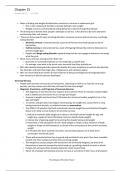Summary
Summary of Psychological Disorders- PSY 325 (Chapters 1-5, 7-9, 11-13, 15, 17)
- Course
- PSY 325 (PSY325)
- Institution
- Ryerson University (Ru )
This document contains a comprehensive set of detailed notes taken from the textbook for PSY 325 (Psychological Disorders;(Chapters 1-5, 7-9, 11-13, 15, 17). The notes summarize key concepts, theories, and findings discussed in the chapters required for the course, providing a structured and access...
[Show more]



